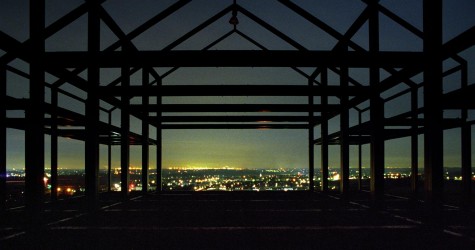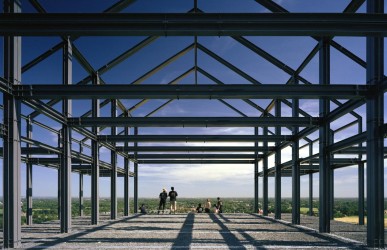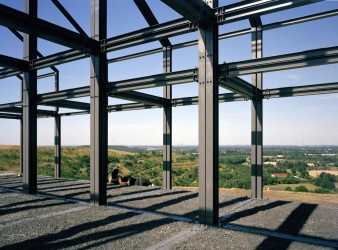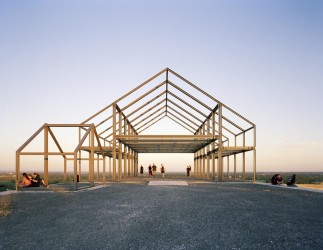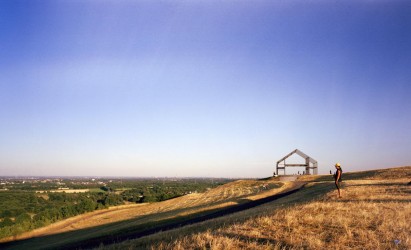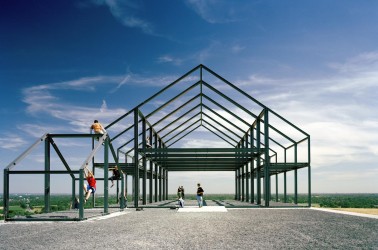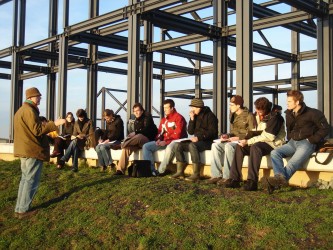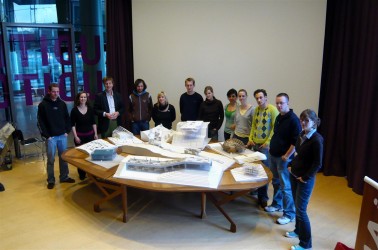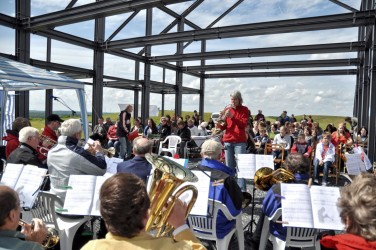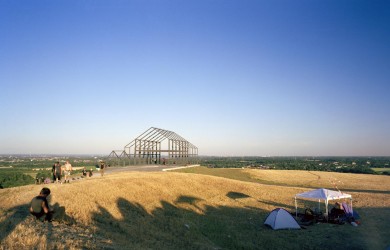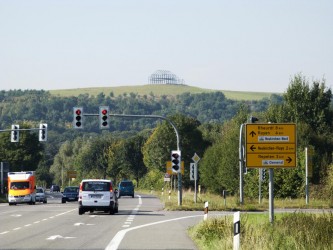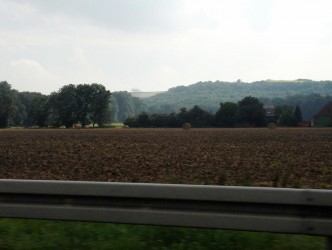Steel sculpture on a coal slag heap alongside the A57 motorway. The hall is 16 metres long, 14 wide and 10 high. It is a landmark, a place of tranquillity and a historical reference. It is also the main building of the Open-Air University, an educational programme by Observatorium.
DESIGN WHAT IS THERE
Emptiness and silence are hard to design. Where available, Observatorium incorporates these characteristics into the design. There are three ways to do it: do nothing, protect them, and make them visible.
Panorama
Emptiness and silence can be hard to design, and when these qualities are present, the design must aim to protect them. It is important to realize how much mystery and how much perfection a non-designed space possesses. For an incipient recreational facility, for a district which is subject to major economic developments and, especially, for a region where huge power stations mingle with historic farmhouses, the incomplete building is a symbol of change and optimism. Observatorium's Hallenhaus frames the splendid panorama and gives the bare plateau a distinct identity. Despite the openness of the structure, the sculpture feels like an interior with picture windows. It exerts a concentrated force on many visitors. The subtle blend of sanctity and profanity that every large barn possesses is all the more conspicuous here due to the Acropolis-like setting.
Nice story
In Berlin, preparations for Observatorium's Autorenwerkstatt exhibition were interrupted by an unannounced visit by Marie Cathleen Haff, a member of the Dutch Embassy staff. She asked for information and took some of Observatorium's slides with her to illustrate a lecture on contemporary art in the Netherlands. She later heard about the design for Observatorium Nieuw Terbregge, and included an article about it in an embassy publication on contemporary Dutch landscape architecture. She was also responsible for putting Observatorium in touch with Thies Schröder, an organizer of symposiums and an editor of publications about landscape architecture. Schröder invited Observatorium to take part in a panel debate in Potsdam. Even before the start of the debate, Andre Dekker and Prof. Hinnerk Wehberg fell into an animated discussion. The professor ended the day by suggesting to Observatorium: "How about collaborating on a competition entry?" One year later, the newcomers to the discipline of art in the public space found themselves working as a team together with WES & Partner, a large landscape architecture firm from Hamburg. And, a year after that, they won a commission for a huge landscape remodelling project in the Ruhr redevelopment region.
Slag heap
Halde Norddeutschland is an 80 metre high plateau of 100 hectares in area. This relic of coal mining industry has been designated as a node in a network of sports and recreational facilities in the Niederrhein landscape for the multi-million population of the Ruhr region. Closure of the coal mines caused considerable unemployment in Niederrhein, situated between the Ruhr and the Dutch border. The urban planner Thomas Sieverts, known for coining the term Zwischenstadt (which refers to a sprawling, incoherent style of development which is neither town nor country), drew up a plan to promote leisure development in the area: Landschaftspark Niederrhein. Halde Norddeutschland is a centrally located attraction within this plan. It is a parkland area suitable for walking, cycling, paragliding, equestrian sport and much else. It is also intended to attract investors in recreational amenities. The core aims of the project were threefold: integration of the slag heap into the landscape, development of the heap into a recreational facility (which would generate new jobs) and creation of a landmark.
Mount of Silence
WES & Partner and Observatorium entered the design competition and were so impressed by the landscape potential of the slag heap, that they chose Kein Remmidemmi ("cut the noise") as a motto for their design. The heap must not be turned into a plinth for the leisure industry, but into a place for contemplation. If building had to take place there, then it ought to be something for monks and seekers after tranquillity. Instead of using the elevation to build toboggan runs and restaurants, the designers visualized a monastery with a central courtyard. WES & Partner found a monastic community whose members were amenable to relocation, and pulled out all the stops to convince the jury of the importance of peace, quiet and wellness. They marked the vanished river courses around the plateau with large circles of trees, and designed a Himmelsleiter (Jacob's Ladder) monument. Observatorium designed a landmark for the location. The design won the first prize, but then it had to be adapted quickly to the reality of a declining economy.
location: Halde Norddeutschland, Neukirchen-Vluyn
year:2006
images:

